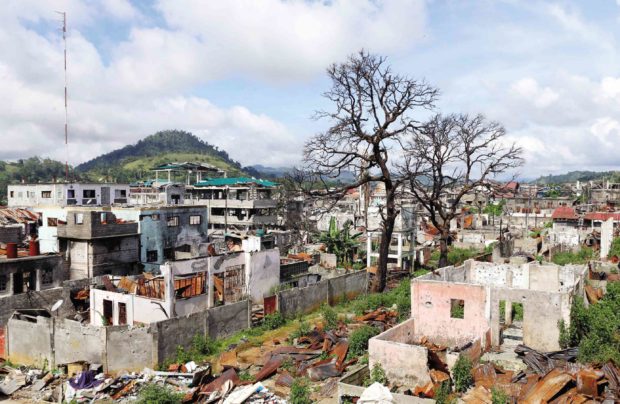Modern city to rise from Marawi rubble

A section of Marawi City’s business center is destroyed after a five-month war between government troops and Islamic State-inspired terror groups. —JEOFFREY MAITEM
After a five-month battle between government forces and Islamic State-inspired terrorists that reduced Marawi City to rubble, a modern city is envisioned to rise from the ruins of this Lanao del Sur provincial capital, said an official of a government task force leading the city’s rebuilding.
Eduardo del Rosario, Task Force Bangon Marawi chair, said the government has received six proposed master plans for the rehabilitation and reconstruction of Marawi, with costs ranging from P38 billion to P86 billion.
Del Rosario said a multiagency technical working group (TWG) would evaluate the six proposals from which it would select what it considers to be the best.
The TWG consists of representatives from the Department of Finance, National Economic and Development Authority, Department of Budget and Management, Department of Public Works and Highways, the Housing and Urban Development Coordinating Council, and the Bases Conversion and Development Authority.
Once the TWG selects a proposal, it would be subjected to a Swiss challenge, where another developer would submit a competing bid.
Article continues after this advertisementIn a press conference in Lanao del Sur on Wednesday, Del Rosario said the government would select either a lower bid offering the same quality as the chosen proposal, or a “better offer” to the one proposed by the lowest bidder.
Article continues after this advertisement“So we will get the best offer that we can have and we can be assured that the government will get the best developer in this project,” he said.
The reconstruction of Marawi will be a build-transfer or turnkey project, where the developer will design and construct the project before turning it over to the government, he said.

Accompanied by soldiers, a group of mayors and officials of Lanao del Sur province visits Marawi to see the ruins of the provincial capital. —RICHEL V. UMEL
Presidential spokesperson Harry Roque said this mode was chosen because President Duterte himself thought biddings could be prone to rigging and other irregularities.
Del Rosario said he expected Marawi’s rehabilitation to begin in April or May next year.
The plan includes the removal of the remaining shells of buildings in the central business district, which will be rebuilt, he said.
The proposed improvements include widening the roads, bringing power lines underground, and building a sewage treatment plant to ensure that wastewater discharged into Lake Lanao had been treated, he said.
The plans for Marawi also include the construction of a grand central market and three public markets, an economic zone for manufacturing facilities, and a sports complex.
In the meantime, the government will provide 1,170 temporary shelters with running water and electricity for displaced residents.
Del Rosario said the turnover of these housing units would be completed by the end of February.
The fighting in Marawi displaced more than 200,0000 residents, nearly half of whom
had been allowed to return to their home villages starting last month.














